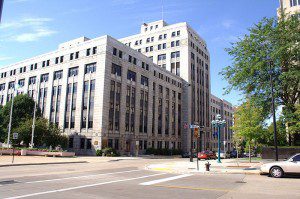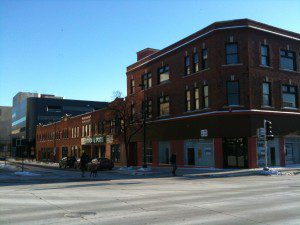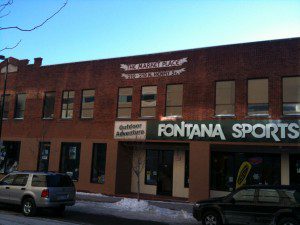The loss of the rail connection to Milwaukee and associated train station project in Downtown Madison has caused us to step back and reconsider redevelopment plans for the two blocks at Government East. I have just a few long-shot ideas – the public market should be just off of State at North Henry, and the new hotel should be at the state office building at 1 West Wilson. These are quite possibly totally infeasible ideas, but they at least illustrate larger issues that we need to think about.
The “Public Market Square Development District”, and specifically the two blocks at the Government East parking ramp, was an agglomeration of several projects combined by an extraordinary alignment of civic needs: the Government East parking ramp is at the end of its functional life, the Monona Terrace desperately needs additional connected hotel space, the Madison Public Market is looking for a location with enough consumer traffic to support a diverse market, and a high rail station offering connections to Milwaukee, Chicago, and beyond would be located across the street. All of these things came to a head right at the same time, and Mayor Cieslewicz recognized that combined, these four projects offered a tremendous opportunity to really activate the southeast side of the Capitol Square, and make a stronger connection from the base of Bascom Hill to the shore of Lake Monona.
As we now know, the keystone of this project is off the table for a couple of years, but even without the rail station, we still have to address the other issues. While we still may be planning for a day when a downtown station is built, we should also consider what is best for each of the other projects, standalone. I think that leads to different locations.
* * * *
It is now well-established that additional, connected hotel rooms for Monona Terrace is important for it to be able to grow as a convention center. (We’ll ignore that it doesn’t help it at all become a better community center, and in fact probably makes it worse as a community center, but Robbie Webber has said all that needs to be said on that issue. )
Building a connected hotel means we can’t place the hotel that far from the Monona Terrace. (And ignore anyone who tells you that it doesn’t have to be connected, just close. No convention planner will chose Wisconsin if it means you have to walk 3 blocks outside to get to the hotel.) The plan that has attracted the most interest is to build at Madison Municipal Building (MMB) and connect to the Hilton via a skybridge over East Wilson. Marcus Corporation has held the right of first refusal for a hotel at this location, though that expires this year.
The main reason we’re thinking about that location? We already control it. The city owns the property, so there’s no hassle in trying to steer the market into building there, or even worse, having to resort to some sort of eminent domain acrobatics to make it possible. But is it the best location for a hotel, and more importantly, is there anything else in the area that would be better suited as a hotel?
Where should the new hotel be located? Right next door to the Monona Terrace, on the other side from the Hilton, at the State Office Building on 1 West Wilson St.

(Image courtesy of Dori on Wikipedia)
In terms of distance traveled for a convention go-er, admittedly it’s not a huge improvement over MMB, though that said, the connection direct to the Monona Terrace will feel much more natural than having to cross through the first hotel (the Hilton) to get to the second hotel at MMB. I don’t think I can quantify it, but I and anyone who’s ever spent a lot of time at conferences, tradeshows, and conventions can assure you, it’s a real feeling and noticeable.
The State Office Building, besides having much better lake views than a hotel at MMB, is also a beautiful building on its own. Reinvigorating it with a hotel conversion gives us an opportunity to put private money into a beautiful historic structure, and protect it for years going forward. Frankly, and this isn’t an attempt to bash state workers, I’d rather use this gem of a building as a way to sell Madison to visitors with an enhanced experience, than give state workers a great lake view.
If I want to take away the great lake views of state workers, where could or should they go? I think there are plenty of opportunities in and around the square where they could go, either in existing office space, or as anchor tenants in new developments at the Brayton Lot, next to the GEFs, or perhaps something at the 100 block of West Mifflin. As a guaranteed anchor tenant, it could developers some freedom in building a project where the office space is just one component.
There are two huge obstacles. First, will the State sell it? This is an instance where having Scott Walker as Governor is actually helpful, because he’s more open to the idea of selling off state assets than is perhaps good for the state.
The second is does this redevelopment work at all economically? Can you affordably retrofit the building with everything a modern hotel needs – banquet rooms, restaurants and bars, recreation facilities, expanded plumbing to every room, and so forth? I have no idea. If it’s not, then this whole idea is a waste of time. However, long term for the area, it’s better to put the hotel there and leave our options open at the MMB.
* * * *
The next component to consider is the Madison Public Market. Now, I admit that personally, I’m not that excited about a public market. I’m not a big fan of shopping for shopping’s sake, and when I do shop for fun it’s electronics or books. Just flipping through the vendor list at Pike’s Market in Seattle, which is somewhat the inspiration for the Madison Public Market, I don’t see much that would get me to go on any regular basis. I can see the value of the public market and why a great many people are excited about it, and still support the idea, but like campgrounds it’s not anything I’m interested in using.
To make the public market work, though, we have to maximize the visitor traffic nearby. In the greater scheme of things, Madison is simply not a very big city, and we need every trick we can pull out to build density levels around it to that of a much larger city. It is not strong enough on its own to support itself, and we need it to feed off of other uses – and to reciprocate in turn. In Madison, that means connecting directly to State St.
When the city studied four possible locations for the public market – Union Corners, The Mautz Paint site on East Wash, the Brayton Lot, and the Government East site – all of them were similar in that they are essentially greenfield/brownfield developments: no existing businesses would be disrupted to bring the public market there. Former Alder Tim Gruber, one of the original proponents of Govt East as a public market site, wrote that he didn’t think a State St location was available. And if you apply the greenfield test of building where there is absolutely nothing currently there, then that’s basically true. But if you’re willing to relax that requirement a bit, then there are more options.
The 200 block of N Henry, across the street from Overture, is a great location for the public market. It connects right to State Street – foot traffic from State can easily reach the public market, and visitors to the public market can continue on to State St. On busy Farmer’s Market Saturdays, when the crowds already head down State St, the public market is within that critical first two blocks. It’s not a question of which way should people go – they’re already heading that way. During the business day, State St is busy with traffic from the UW and from the Square. For people elsewhere in town, there is easy parking at the Overture Ramp and at the Carroll St ramp.
Sizewise, it’s not quite right: The public market plans are aiming for 67,000 square feet. I can’t get an exact figure out of the assessor’s data, and with remodeling the number would change anyway, but the lot easily supports 25,000 on one floor, and if you’re willing to consider two stories now we’re in ballpark. Finally, an aerial view shows that there is space that it could expand into.
View Larger Map
The building even already says “Marketplace” on the front door.
The obvious downside: while it’s mostly empty, it’s not completely empty. Fontana Sports sits right square in the middle. A Room of One’s Own is on the Johnson Street end. There’s something around back, too, that’s slipping my mind. If the building needs to be expanded, BDC camera repair and a vintage clothing store are a bit farther down on Johnson St. All of them are tremendously good businesses, and a move on them could be hard. Fontana in particular – it just moved, and bless their hearts they stayed downtown. Should we ask them to move again? If we can do right by them, then I think we should.
If we show them the money, can they thrive somewhere else? I think they can. A Room of One’s Own is probably stronger fronting right onto State St. BDC is doing more and more mail-order business, and perhaps with a small storefront on State with a larger 2nd floor presence does just fine. Fontana is harder, but I think we can make it work.
Building above a new Government East makes parking easier there than North Henry Street. North Henry doesn’t really much help the Monona Terrace, or an eventual hotel, nor benefit from a train station, but for the market’s sake, I’d gladly trade all of that for a stronger market.
The larger point: the public market will do better there than any of the four sites previously studied. State St does best if the public market is at North Henry instead of South Pinckney.
It’s more complicated, sure. The economics may not work out. It may be too much of a hardship to place on some businesses that have been nothing short of fantastic downtown citizens. But it didn’t even get studied. If we’re serious about making the public market succeed, let’s at least consider it.









Erik, we were told that building the Hilton adjacent to Monona Terrace was the answer to bringing in larger conventions. It wasn’t. Now hotel developers in search of TIF handouts claim we just need ANOTHER connected hotel and the big conventions will come. They won’t. Big conventions pick cities with major hub airports rather than regional airports with limited and expensive daily flights.
Oh come on, there will never be big conventions here. Most big convention centers in the US are bigger than the whole city of Madison. And some of them like Philadelphia’s just keep getting bigger.
The Hilton was built too small, as a compromise with other hotels in the area. Everyone knew it was too small, but it was better than nothing. Conference and Convention business would be much, much smaller at the MT without it.
The Monona Terrace will obviously never compete with Javits in New York or McCormick in Chicago, and we’re not competing for the big Auto Shows or the Consumer Electronics Show.
We are competing for many smaller conferences – 500 to 1000 attendees – and we’re losing out because the Hilton, and hence Monona Terrace, only has 240 hotel rooms.
Here in the Computer Sciences department, virtually every group and faculty member is deeply involved with the national associations, and the field-specific subgroups of the national associations. Occasionally we’re able to bring those things to Madison – my own group hosted one of the main academic database conferences in 2002 at the MT, and other fields in my department have done so as well. However, I also personally know of other conferences in Computer Sciences that have considered and rejected the MT because of the hotel room situation, and I have to believe that this is common across the University, and the broader Madison community.
There’s an old saying that the plural of ‘anecdote’ is not ‘data’, but I believe there is evidence out there that the MT would see more business with additional, connected hotels.
This may not be appropriate to this particular post, but I feel strongly about reiterating my previous comment:
February 1, 2011 at 6:27 am
These Private-Public partnerships are getting out of hand. Use of City assets and access to the public’s fiscal deep pockets and superior bond ratings for the express purpose of generating benefit to private profit for connected individuals who socialize the normal cost of business is going to bite the City in the butt. Soon cronyism will become the operating model for growth. Then elected and appointed local officials will be working on behalf of the most influential interests. and the Public Trust will be a pleasant bedtime story. If it is that good of an idea, it should attract plenty of private capital. If it is that needed a service, the public would demand the City establish it. Either way the hybrid invites loss of public accountability.